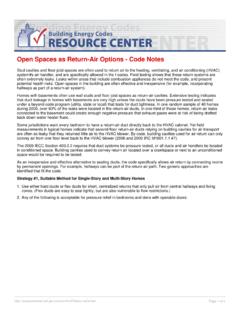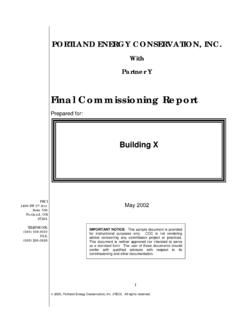Transcription of FACILITY SHUTDOWN MANAGEMENT: BEST INDUSTRY …
1 WHITE PAPER | PHARMA BIOTECHM artin Lush underlines the importance of controlling plant shutdowns so that start-up is on time with minimal disruption to the ongoing supply of products. We all have our war stories of shutdowns dragging on for weeks, not days, and it is worrying that after many engineering interventions it can take weeks or even months before the FACILITY performs as well as it did beforehand, says Martin. What can you do to make sure this important event is performed rapidly, under close control and within the cGMPs? FACILITY SHUTDOWN MAINTENANCE: THE CONTEXTF acility or planned SHUTDOWN maintenance is vital for any production FACILITY . Access to these plants and equipment is usually restricted during routine operations, so planned shutdowns provide the opportunity for the engineering team to complete major maintenance to the plant as well as shutdowns can come in many shapes and sizes! >The genuinely planned! These are usually scheduled well in advance for large-scale maintenance activities.
2 The number of these planned shutdowns depends on the nature of the manufacturing process and how hard the plant is working, the so-called plant utilization. The greater the plant utilization, the more (preventative) maintenance is required. When companies wrongly perceive these to be a cost, not an are in trouble. This is like waiting for your car to break down rather than having it regularly serviced >The unplanned emergency SHUTDOWN . A leaking pipe or a catastrophic equipment failure usually happens when you least expect it and usually at the worst time possible. To fix it, the plant must be shut down quickly in a controlled way >Full and partial shutdowns. Planned shutdowns usually involve closing the entire plant. Emergency shutdowns sometimes require only partial closure, presenting some unique challenges for startup and maintaining high quality product supplyShutdowns represent a high risk to your operation and are costly! >Lots of contractors and third parties are usually involved.
3 All must be managed >The build up to shutdowns can be rushed as plants frantically attempt to catch up with stock build and manufacturing schedulesFACILITY SHUTDOWN management : best INDUSTRY PRACTICESTO ENSURE A SMOOTH SHUTDOWN AND A RAPID STARTUPby Martin Lush >It s amazing how some equipment never works as well as it did before it was stopped and had parts replaced! This can lead to delays, stress and frustration as plant engineers struggle to hit deadlines for startup. This burn in period can stretch for months and lead to further interventions and costly GMP incident investigations >Change control! Changes to plant and equipment have to be reviewed within hours, not days or weeks; and the expertise has to be on hand to make this happen >Long hours. It is not uncommon for engineering teams to work 24/7 to get the job done. Fatigue + Stress = Mistakes >Since Job A must precede Job B, careful planning and scheduling is vital >Too many cooks. Contractors, engineers, validation specialists, QA, QC, Procurement, Operations; all have a part to play.
4 Without leadership, planning, control and short interval management , the outcome could be disastrous >Contamination control. It is often the case that the job people least like doing is usually the most critical. In this case, post SHUTDOWN cleaning and sanitization can be a real chore yet they are critical in re-establishing environmental standards and controlNo matter what type of SHUTDOWN (planned or emergency), the key to success is organization and discipline: >Clearly defined roles and responsibilities >Clear handover between each activity or SHUTDOWN phase >Attention to detail, particularly cleaning and sanitization >Exquisite control over plant access, contractors and CHANGES to plant, process and equipmentWe hope the following checklist will help you! SHUTDOWN management : THE PRACTICENo matter what type of SHUTDOWN it is, there are usually five key phases, each with key considerations. Think of it like a relay race:Phase One: Pre- SHUTDOWN Activities (Planning and Scheduling)Phase Two: Declassification and HandoverPhase Three: Day-To-Day management and HandoverPhase Four: Reclassification and HandoverPhase Five: Post- SHUTDOWN Activities and Completion of the SHUTDOWN ReportPHASE ONE: PRE- SHUTDOWN ACTIVITIES (PLANNING AND SCHEDULING) Confirm who must do what.
5 Accountability and specific responsibility for key SHUTDOWN roles: > SHUTDOWN coordinators/planners > SHUTDOWN leader >Plant owner Your SHUTDOWN management team. Who must be involved: >Engineering >Validation/technical operations >Manufacturing operations >QA >QC >Procurement >Safety >Planning or S&OP team Generate a list of all SHUTDOWN activities to assess: >Resources required (who, what, when) >Timelines for each SHUTDOWN activity >Lockdown dates to prevent any further additions to the schedule that can t be planned for >Pay particular attention to any task that will directly impact all others, power supply outage and smoke pattern testing Contractors and third parties: >Competency screening and risk ranking. Are your contractors skilled and competent? Which will be responsible for conducting high-risk activities where the consequence of errors and mistakes could be costly? >Contractual arrangements signed and sealed. What they can and can t do clearly defined and documented >Control, communication supervision and management : Who will check their work once completed?
6 >Contingency planning. What if key contractors are unavailable? Do you have a plan B? >Keep an eye out for subcontractors being engaged without the knowledge and consent of the SHUTDOWN owners! They can wreak havoc Equipment replacement, consumables and spare parts (availability and lead time). Make sure you have plenty of the obvious available: >Gowns/Tyvek suits >Cleaning agents of all types >Filters Completion and publication of a Gantt chart showing key activities, resource requirements, roles and responsibilities for all key stakeholders and the exact support requirements: >Contractors >Manufacturing/operations >Engineering >Validation >QA >QC Change control. Make sure that any planned changes to the plant and equipment are approved well in advance of the SHUTDOWN , not on the day Criteria for handovers between each SHUTDOWN phase. Who will check and verify what, when and how? Making sure QA is involved in the approval process is key so that oversight can be maintained and the impact on products release assessed It is vital to remind people that a plant in SHUTDOWN is still a GMP FACILITY , not a building site.
7 Make sure you have signage that gets this point acrossPHASE TWO: DECLASSIFICATION AND HANDOVER Removal of everything that can be moved from the plant. All movable equipment and materials should be bagged, tagged and stored to prevent contamination Equipment that can t be moved should be securely covered. Open pipes must be sealed/capped off to prevent contamination Protection of walls and floors. During major shutdowns, walls and floors can be damaged requiring costly delays for additional repairs. If you expect a lot of heavy SHUTDOWN work, make sure you protect them Sampling and monitoring points capped or sealed. If you have monitoring points, make sure these are sealed off Audit (plant review) and sign-off vs. detailed checklist. Before you move to Phase Three, make sure you walk the plant to ensure that everything that should have been done has been done!PHASE THREE: DAY-TO-DAY management Controlled access. Shutdowns are not a free invitation for anyone to enter the plant.
8 The more people wandering around, the greater the chance of losing control of the SHUTDOWN . Restrict access to those that matter Clothing requirements. Tyvek suits should be the minimum Contractor management : >Permit to work system (or equivalent) to ensure that contractor s tasks are agreed to beforehand and verified upon completion. A central location ( control room ) for all work management is key. Visible, constantly for people to go >Supervision. Make sure you have people providing day to-day oversight and supervision of contractors based on the criticality (risk) of what they are doing >Verification upon completion >Remember, some contractors may not have a detailed understanding of the demands of working in a GMP environment. Make sure you provide an experienced local guide to oversee and to make sure they meet GMP requirements DAILY change control committees. Shutdowns can involve a lot of changes to equipment and the plant. Make sure these can be fast tracked for speedy approval with daily, face-to-face change control committee meetings for review and approval Requalification of equipment and plant.
9 Any significant change to the plant and equipment usually requires requalification. Make sure it s done Waste removal. Major shutdowns can lead to considerable waste. Make sure this is removed immediately and is not allowed to build up Cleaning. During major shutdowns make sure cleaning accompanies every major activity to ensure contamination is controlled throughout, making the final cleandown easier Daily snagging. Even the best planned SHUTDOWN rarely goes according to plan! After each day, complete a review of what is on track and what is not. What has gone according to what has not. This review of the snags or problems helps you in your contingency planning DAILY contingency planning with all key stakeholders. What extra resources are needed? How can additional risks be managed or contained? If you anticipate any delay to successful startup, inform your colleagues in planning ASAP! They hate surprises A DAILY plan, do, review and adjust must take place at the start of each day with all key stakeholders to ensure everyone knows what s going onPHASE FOUR: RECLASSIFICATION AND HANDOVER Review and approval of requalification activities: Make sure that all equipment is operating within its validated state Deep clean.
10 This is one of the most vital activities of any SHUTDOWN and yet the one activity often poorly done. Sanitizing agents applied to dirty surfaces, hard to clean locations ignored, activities rushed, insufficient contact all delay efficient startup due to poor environmental control. Here are the key phases: >Firstly make sure your cleaning and sanitizing pattern or sequence does not contaminate already clean surfaces. Starting from the areas where product is open moving outwards; with the changing rooms and transfer hatches last on the list >Pre-clean environmental monitoring. It s a good idea to take surface samples (swabs and contact plates) from a wide range of locations before any cleaning and sanitization activities. Pay attention to those notoriously difficult to clean locations >Detergent wash. Most sanitization agents are only effective when applied to surfaces free from dirt. Cleaning all surfaces with a detergent is key >Sanitization of all surfaces with a broad spectrum agent >Sporicidal clean!
















